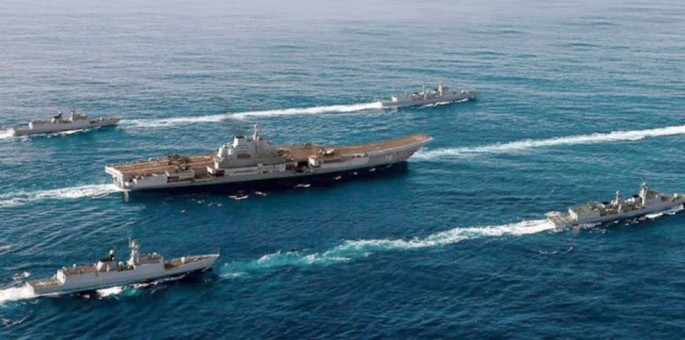The ongoing show of force by a carrier strike group led by the aircraft carrier CNS Liaoning (CV-16) has illustrated the strengths and weaknesses of the People's Liberation Army Navy Surface Force (PLANSF), according to Chinese military commentators.
The Liaoning departed its homeport of Qingdao Dec. 16 with an escort force of seven warships consisting of three guided missile destroyers (probably Type 052Ds); three frigates (probably Type 054As) and one supply ship.
The stated purpose of the naval excursion was to showcase "the carrier's battle readiness and defense capabilities," said a Chinese military website.
PLAN said the training "strengthened the synergy among different vessels in the formation and refined its overall capability." It also noted the training and tests were "normal arrangements in accordance with annual plan made by the navy."
The destination of Liaoning's group was the Western Pacific where it conducted live fire drills involving the escort force and the Liaoning's Shenyang J-15 fighters.
On Dec. 25, the battle group on its way home sailed to within 90 nautical miles south of Taiwan in the Bashi Channel between Taiwan and the Philippines. It sailed past the Pratas Islands, an atoll controlled by Taiwan in the northern part of the South China Sea, before turning south into the South China Sea.
While the composition of this battle group is traditional, or similar to that of the U.S. Navy, it illustrated the disadvantage of not having a guided missile cruiser with longer range radar and longer range surface-to-air missiles (SAMs) and anti-ship missiles (AShMs).
"In this battle group, the destroyers are responsible for early warning air-defense and anti-aircraft missions, and the frigates defend against anti-surface vessels and anti-submarine missions," said Zhang Junshe, a senior researcher at the Naval Military Studies Research Institute.
This omission makes a PLANSF carrier wing more vulnerable to air and missile attack at longer ranges.
Another weakness, and a more serious one in a strategic sense, is China's lack of overseas bases.
"So far, we don't have any overseas naval port, so the aircraft carrier and the battle group only rely on supply ships. Therefore, it limits our offshore training period," Zhang pointed out.
Zhang said the Liaoning's sorties are mainly aimed at training personnel and conducting research rather than preparing the carrier for battle, so there's no point comparing the Liaoning to U.S. aircraft carriers, which are always battle ready.
"In addition, the U.S. Navy requires global deployment and presence, but our navy's defense duty mainly focuses on near sea and offshore defense," said Zhang.
Zhang, however, takes pride in saying the deployment of the Liaoning in open seas shows the carrier is combat-ready just four years after its commissioning.
"Compared with other countries, China has progressed ahead of expectations. Other countries' aircraft carriers normally spent 5-6 years or even 10 years to gain combat capability," said Zhang.



























